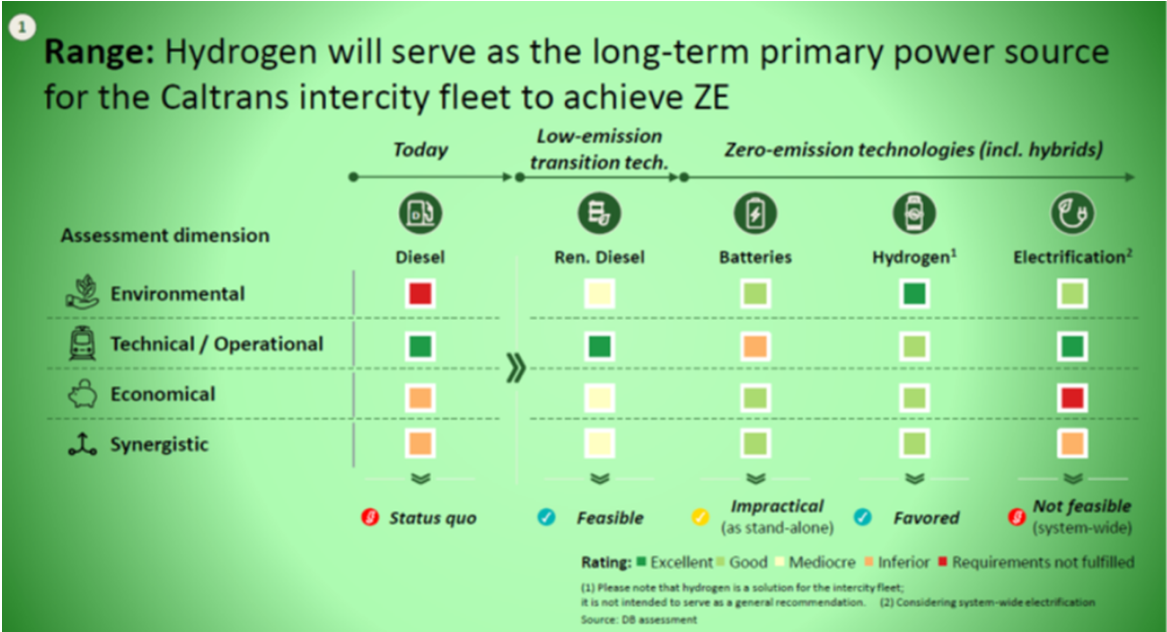Little more than hot air behind Caltrans’ justification for $207 million in unproven hydrogen trains
Over the past few years California has demonstrated remarkable coordination across many areas of state government to develop the market for hydrogen, driven largely by ARCHES, California’s hydrogen hub, a public-private partnership run out of the Governor's office and funded by Biden-era tax credits . In the rail sector, these actions include the now withdrawn In-Use Locomotive Rule, which counted fossil fuel-derived hydrogen as “zero emissions”, and CalSTA’s still-relevant purchase of 10 hydrogen fuel cell trains (with an option to purchase 19 more). These trains were purchased at the considerable cost of $21 million each for low capacity trainsets, with no clear end use, despite hydrogen trains being an immature technology with no history in North America and a rather poor track record outside of the US. Hydrogen trains have real environmental and operational disadvantages, threatening service disruptions and the locking in of current anemic levels of service for decades, so what was Caltrans’ justification for this unusual purchase? Little more than colored squares on a chart, with no detailed technical analysis.
We break down the flaws in Caltrans’ reasoning in our latest whitepaper.

Environmental Comparison
Caltrans bizarrely ranks electrification as worse for the environment than hydrogen, which is an indirect greenhouse gas that easily escapes into the atmosphere, is mostly produced from fossil fuels with similar greenhouse gas impact to diesel, still uses 3 times more energy than electrification even for ‘green’ electrolytic hydrogen, consumes fresh water, and poses considerable safety hazards from leaks and explosions. A rail strategy built around hydrogen trains will hold back California’s vehicle miles travelled (VMT) reduction progress - the most impactful way rail can benefit climate. Caltrans’ justification for their ranking? “Visual impacts” from overhead wires.
Technical/Operational Comparison
Caltrans’ analysis downplays the costs and risks associated with the underdeveloped hydrogen supply chain, while ignoring hydrogen’s inability to meet current capacity or future speed requirements. Caltrans also does not even pay lip service to safety, which is the number one priority for transporting passengers.
Economic
Caltrans’ economic analysis downplays the high cost of hydrogen fuel cell rolling stock (both capital and O&M) and ignores the large capital costs associated with hydrogen refueling and safety infrastructure - which have seen large cost escalations at SBCTA’s first in the nation hydrogen Arrow service between San Bernardino and Redlands, now delayed for almost a year. In the long term and at higher levels of service, overhead electrification is the most cost-effective way to power a train. Caltrans’ economic analyses are largely motivated by the $7 billion in federal money awarded to the ARCHES hydrogen hub, which is now in jeopardy due to the Trump Administration.
Synergistic
Hydrogen trains may be synergistic for the industrial hydrogen industry or Sempra, but not for a rail network. With hundreds of miles of overhead catenary in progress between Caltrain, California High Speed Rail, and Brightline West, overhead electrification is already the dominant zero emissions rail technology in the state. Thankfully the 2024 State Rail Plan recognizes this and calls for 1500 miles of overhead catenary, a major reversal from the 2022 hydrogen strategy critiqued here. Nevertheless, areas of the state rail network where CalSTA’s 10 hydrogen fuel cell trains will be deployed will be disconnected from the wider network for the lifetime of the rolling stock - the opposite of synergy.
Hydrogen Trains in the Real World
Real world experience in Germany shows hydrogen trains have been a failure. The EBV line in Lower Saxony, Germany was the first in the world to run hydrogen trains in service, and saw chronic disruption from mechanical issues as well as shortages in hydrogen fuel. Meanwhile, the RMV line in Hesse near Frankfurt, saw a 19% reduction in service due to mechanical issues with its hydrogen trains, and offered an unprecedented two months in free service in an attempt to regain public trust. Both agencies have had to reintroduce diesel service to replace unreliable hydrogen trains, and are pursuing electrification moving forward. Rail agencies in Bavaria, Baden-Württemberg, and Austria have come to similar conclusions and have selected electrification over hydrogen trains due to cost and reliability issues.
Read the full report for our detailed takedown of all the flaws in Caltrans’ reasoning, and to understand fully why hydrogen trains are the wrong technology for California’s rail system.